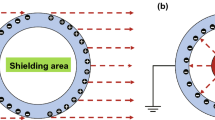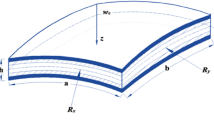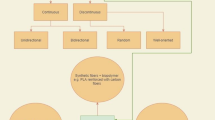Abstract
The effective permittivity of composite materials depends highly on the geometry, the arrangement, and the permittivity of each component. This research proposes a new numerical method that takes into account those dependencies through assemblies of virtual capacitors (electrical circuit). Then, the effective permittivity is calculated from the equivalent capacity of the suggested circuits. The new presented method delimits the effective permittivity of heterogeneous materials through two obtained different summation expressions. This new method was applied to some inclusions to investigate its validity by comparing its results to the existing models and the results of the finite element method. The new results are shown in good agreement with the literature. Moreover, the presented model takes less time in simulation to estimate the effective permittivity compared to the finite element method. The new model can be applied to all kinds of composite materials including the ones that involve multiple phases and complex geometries.













Similar content being viewed by others
Data Availability
The data that support the findings of this study are available on request from the corresponding author. The data are not publicly available as the data also form part of an ongoing study.
References
Khairy H, Harith ZZT (2011) Influence of pore geometry, pressure and partial water saturation to electrical properties of reservoir rock: measurement and model development. J Pet Sci Eng 78(3):687–704. https://doi.org/10.1016/j.petrol.2011.07.018
Zhdanov MS (2018) Chapter 10: electromagnetic properties of rocks and minerals. In: Zhdanov MS (ed) Foundations of geophysical electromagnetic theory and methods, 2nd edn. Elsevier, Amsterdam, pp 353–400. https://doi.org/10.1016/B978-0-44-463890-8.00014-1
Mehrotra S, Kumbharkhane A, Chaudhari A (2017) Chapter 10: permittivity study of bloods, saliva, tissue cells, and their applications in medical instrumentations in the detection of oral cancer. In: Mehrotra S, Kumbharkhane A, Chaudhari A (eds) Binary polar liquids. Elsevier, Amsterdam, pp 429–439. https://doi.org/10.1016/B978-0-12-813253-1.00010-0
Hesabgar SM, Sadeghi-Naini A, Czarnota G, Samani A (2017) Dielectric properties of the normal and malignant breast tissues in xenograft mice at low frequencies (100hz1mhz). Measurement 105:56–65. https://doi.org/10.1016/j.measurement.2017.04.004
Halter RJ, Schned A, Heaney J, Hartov A, Schutz S, Paulsen KD (2008) Electrical impedance spectroscopy of benign and malignant prostatic tissues. J Urol 179(4):1580–1586. https://doi.org/10.1016/j.juro.2007.11.043
Amato MT, Subroy V, Gimnez D, Strom PF, Krogmann U (2019) Dielectric permittivity water content relationships in woodchips: particle size and temperature effects. J Hydrol 572:251–260. https://doi.org/10.1016/j.jhydrol.2019.02.047
Sihvola A (2013) Homogenization principles and effect of mixing on dielectric behavior. Photon Nanostruct Fundam Appl 11(4):364–373. https://doi.org/10.1016/j.photonics.2013.01.004
Wiener O (1912) Die Theorie des Mischkörpers für das Feld der stationären Strömung. erste abhandlung: Die Mittelwertsätze für Kraft. Polarisation und Energie, vol 32, no 6, Leipzig, pp 509–604.
Hashin Z, Shtrikman S (1962) A variational approach to the theory of the effective magnetic permeability of multiphase materials. J Appl Phys 33(10):3125–3131. https://doi.org/10.1063/1.1728579
Krischer O, Kröll K (1956) Die wissenschaftlichen Grundlagen der Trocknungstechnik. Springer, Berlin. https://doi.org/10.1007/978-3-662-26010-4
Bawuah P, Chakraborty M, Ervasti T, Zeitler J, Ketolainen J, Gane PA, Peiponen K-E (2016) A structure parameter for porous pharmaceutical tablets obtained with the aid of wiener bounds for effective permittivity and terahertz time-delay measurement. Int J Pharm 506(1):87–92. https://doi.org/10.1016/j.ijpharm.2016.04.026
Wang M, Pan N (2008) Predictions of effective physical properties of complex multiphase materials. Mater Sci Eng R Rep 63(1):1–30. https://doi.org/10.1016/j.mser.2008.07.001
Sareni B, Krhenbhl L, Beroual A, Brosseau C (1997) Effective dielectric constant of random composite materials. J Appl Phys 81(5):2375–2383. https://doi.org/10.1063/1.364276
Looyenga H (1965) Dielectric constants of heterogeneous mixtures. Physica 31(3):401–406. https://doi.org/10.1016/0031-8914(65)90045-5
Patil SK, Koledintseva MY, Schwartz RW, Huebner W (2008) Prediction of effective permittivity of diphasic dielectrics using an equivalent capacitance model. J Appl Phys 104(7):074108. https://doi.org/10.1063/1.2976173
Araujo MC, Costa C, Lanceros-Mndez S (2014) Evaluation of dielectric models for ceramic/polymer composites: effect of filler size and concentration. J Non-Cryst Solids 387:6–15. https://doi.org/10.1016/j.jnoncrysol.2013.12.005
Kolokolova L, Gustafsonm B (2001) Scattering by inhomogeneous particles: microwave analog experiments and comparison to effective medium theories. J Quant Spectrosc Radiat Transf 70(4):611–625. https://doi.org/10.1016/S0022-4073(01)00033-4
He H, Dyck M, Zhao Y, Si B, Jin H, Zhang T, Lv J, Wang J (2016) Evaluation of five composite dielectric mixing models for understanding relationships between effective permittivity and unfrozen water content. Cold Reg Sci Technol 130:33–42. https://doi.org/10.1016/j.coldregions.2016.07.006
Sihvola AH, Kong JA (1988) Effective permittivity of dielectric mixtures. IEEE Trans Geosci Remote Sens 26(4):420–429. https://doi.org/10.1109/36.3045
Karkkainen KK, Sihvola AH, Nikoskinen KI (2000) Effective permittivity of mixtures: numerical validation by the FDTD method. IEEE Trans Geosci Remote Sens 38(3):1303–1308. https://doi.org/10.1109/36.843023
Myroshnychenko V, Brosseau C (2010) Analysis of the effective permittivity in percolative composites using finite element calculations. Phys B Cond Matter 405(14):3046–3049. https://doi.org/10.1016/j.physb.2010.01.046
Chiteme C, McLachlan DS (2003) AC and DC conductivity, magnetoresistance, and scaling in cellular percolation systems. Phys Rev B 67:024206. https://doi.org/10.1103/PhysRevB.67.024206
McLachlan DS, Blaszkiewicz M, Newnham RE (1990) Electrical resistivity of composites. J Am Ceram Soc 73(8):2187–2203. https://doi.org/10.1111/j.1151-2916.1990.tb07576.x
Yee K (1966) Numerical solution of initial boundary value problems involving maxwell’s equations in isotropic media. IEEE Trans Anten Propag 14(3):302–307. https://doi.org/10.1109/TAP.1966.1138693
Xing Y, Chang Zhao H, Di C (2014) Analysis of equivalent antenna based on fdtd method. Def Technol 10(3):304–307. https://doi.org/10.1016/j.dt.2014.07.005
Hagness SC, Taflove A, Gedney SD (2005) Finite-difference time-domain methods. In: Numerical methods in electromagnetics, Vol. 13 of handbook of numerical analysis. Elsevier, Amsterdam, pp 199–315. https://doi.org/10.1016/S1570-8659(04)13003-2
Kitsunezaki N, Okabe A (2014) Higher-order correction to the fdtd method based on the integral form of maxwells equations. Comput Phys Commun 185(6):1582–1588. https://doi.org/10.1016/j.cpc.2014.02.022
Yang W, Li J, Huang Y (2016) Modeling and analysis of the optical black hole in metamaterials by the finite element time-domain method. Comput Methods Appl Mech Eng 304:501–520. https://doi.org/10.1016/j.cma.2016.02.029
Brosseau C, Beroual A (2003) Computational electromagnetics and the rational design of new dielectric heterostructures. Prog Mater Sci 48(5):373–456. https://doi.org/10.1016/S0079-6425(02)00013-0
Xu L, Liu C, Cao Z, Li X (2013) Particle size influence on effective permittivity of particle gas mixture with particle clusters. Particuology 11(2):216–224. https://doi.org/10.1016/j.partic.2012.07.003
Jarmoumi Y, Najah S, Benzouine F, Derouiche A (2018) A model to predict the effective permittivity of heterogeneous multiphase structures with new bounds. Comput Mater Sci 141:260–268. https://doi.org/10.1016/j.commatsci.2017.09.049
Author information
Authors and Affiliations
Corresponding author
Rights and permissions
About this article
Cite this article
Jarmoumi, Y., Derouiche, A. & Benzouine, F. A New Numerical-Homogenization Method to Predict the Effective Permittivity of Composite Materials. Integr Mater Manuf Innov 9, 423–434 (2020). https://doi.org/10.1007/s40192-020-00194-0
Received:
Accepted:
Published:
Issue Date:
DOI: https://doi.org/10.1007/s40192-020-00194-0




